

Project «Voices of Jewish settlements. Vitebsk region.»פיתוח קשרי התרבות בין העמים של ישראל ובלרוס
|
|---|
Website search |
|
MainNew publicationsContactsSite mapVitebsk regionMogilev regionMinsk regionArkady Shulman
|
Traveling with Arkady ShulmanONLY MEMORY IS LEFT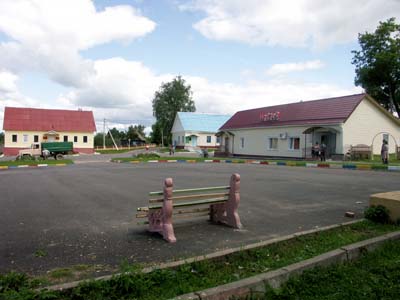 Yanovichi. Central market square. Photo taken in 2008.
Yanovichi. Central market square. Photo taken in 2008.
Yanovichi is an urban settlement 35 kilometers away from Vitebsk. Its population today constitutes 800 people. In 2011 the town will celebrate its 500-year anniversary. The first Jews settled here around 460 years ago. According to a census dating from 1897, the population of the town was 2,359 people, three quarters of them - Jewish. Practically nothing is left today in Yanovichi that could show that Jews used to live here. Only looking at a school map we can see the location of three Yanovichi synagogues. The old Jewish cemetery has for a long time been used as land for agriculture. Not a single trace is left from the Jewish theatre, which once used to be here. 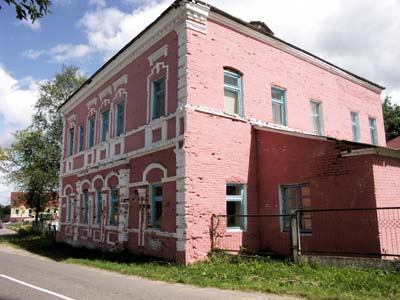 Yanovichi. Former town college. Photo taken in 2008.
Yanovichi. Former town college. Photo taken in 2008.
There is one thing left, though – a two-storey brick house on the central square. It once belonged to Israel Rubashkin. He leased it to a town college at the beginning of the 20th century. After the revolution the building was both a college and a Jewish school. Later it was turned into a hospital department. These days the building is ramshackle and there is a plan to demolish it. Locals are against - it is a part of their history. There is another building on the same square, a dairy shop. It has been renovated with new siding and it is difficult to understand that it’s actually old. But historians know that this once belonged to a Jew who used to dress leather. The square was called Market, or Bazaar square. It was traditional to have a synagogue and a church near shops and stores. The town had rather big trade fairs. This is what an old-timer AlekseyYakovlevich Kolonitsky narrated: “Before the revolution Yanovichi was a busy place. Anything could be bought here: flour, cereals, butter, sugar, salt, burning oil, textiles, haberdashery, shoes, toys, stationery, dishes, confectionery and many other things. Shops were open daily, except for Saturdays… Sunday and Friday were days when trade fairs took place. Sunday was especially busy, since peasants from neighboring villages came to town to attend church, sell and buy things. They would sell milk, butter, eggs, apples, cucumbers, hay, flax, etc. Horses were usually sold by Gypsies but sometimes also by Jews. All factory goods were delivered to Yanovichi from Vitebsk. There were not so many rich merchants. Only the ones who sold flax, textiles and ironmongery made considerable profit.” 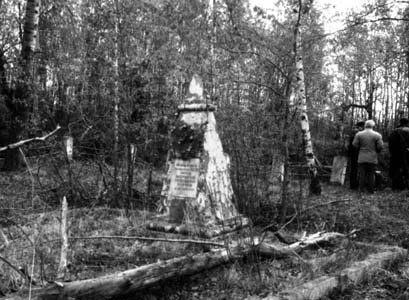 Memorial near grain mill. Photo taken in 1994.
Memorial near grain mill. Photo taken in 1994.
The author of these memories, Aleksey Yakovlevich Kolonitsky, is a gifted and intelligent person. In 1911 – 1927 he taught math and physics at a Yanovichi school. He was a good artist, writer, historian, and took part in the work of the local theatre. Today one street reminds us about the Jews of Yanovichi – Garfunkin Street. Grigory Solomonovich Garfunkin, who was born here, died at the age of 23 during the Dnieper battle. He, together with a group of 36 people, spied on the enemies and revealed their defense plans. He was killed when he was swimming across the Dnieper, while providing cover for other soldiers. He was posthumously instated the Hero of the Soviet Union. Not long ago, while working in Vitebsk regional historical museum, I came across an interesting “Certificate”. It was given to David Aronovich Yakerson and entitled him to make a monument dedicated to Garfunkel. 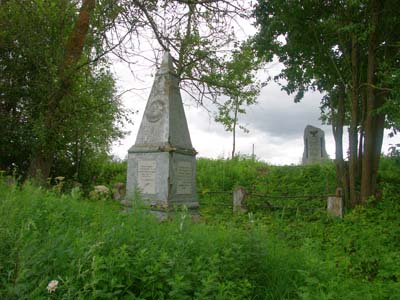 Memorial near grain mill. Photo taken in 2008.
Memorial near grain mill. Photo taken in 2008.
David Yakerson, an artist and sculptor, Jehuda Pen’s student, is well known to historians. The memories of Garfunkel have been erased though. We found out that Lev Garfunkel, born in Yanovichi, became a member of the communist party in 1918. He was 17 or 18 at that time. He believed in the great future for all and was ready to sacrifice his life for that. So, when there was an order to mobilize 10% of communists to the battlefront, he decided to go. Leva died in a battle near Pskov in 1919. I know that no monument has been set up for him in Yanovichi. There were quite a few Jews in Yanovichi who supported the new authorities and fought for a new better life. This was not surprising - they strived for stopping the humiliation: the Jewish Pale, pogroms… Young Jews assumed that fighting for a new life with the new authorities would make them equal to the rest of the population. They were courageous and proud, and naïve. The first political demonstration took place in Yanovichi in 1905. It was organized by local residents: Pertsov, Pukshansky, Genin, Vysotsky and Rivkin. Ivan Gavrilovich Vysotsky was arrested and sent to camps for 15 years for organization and participation in the demonstration… Misha Gruzenberg, who was born in a poor Jewish family in Yanovichi in 1887, became Lenin’s companion and participated actively in promoting the Soviet authority. In the revolutionary world he was known as Mikhail Markovich Borodin. After the revolution he became one of the first Soviet diplomats. In the 50’s, during the Staling repressions, he was arrested and died in prison. There are two more places in Yanovichi that remind us about Jews that once lived here. These are memorials, erected on the site of an execution, which took place in August-September, 1941. 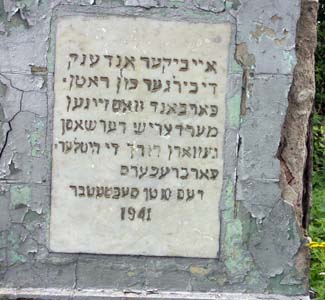
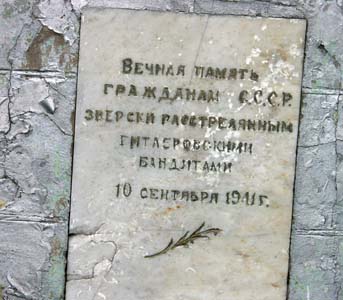 Memorial near grain mill. Photo taken in 2008.
Memorial near grain mill. Photo taken in 2008.
No witnesses of these tragic events are left in Yanovichi today. Anna Yakovlevna Izobova, one of the oldest residents in Yanovichi, used to live in Valki, 3 km away from Yanovichi. She remembers that her parents did not allow her to go to Yanovichi. They knew they were not able to help their friends, who had been locked in the ghetto. Anna Yakovlevna remembers that the local Jews were executed on September 10th, 1941 – she was in Valki and could hear them shouting from such a distance. Twelve years ago I, together with Mikhail Ryvkin, a historian, interviewed Yanovichi residents about those horrible days. These interviews were published in a book “His place will not recognize him any more” and below are some extracts. This is a story of Semen Mikhailovich Rybakov: - As soon as Nazis invaded, which was the middle of June, 1941, they forced locals to do physical work, mostly repair roads. Once, at the end of June, they gatheres 30-40 Jewish men and took them somewhere. An hour later we heard shooting but nobody paid attention – we heard shooting every day. Then we found out these people had been shot near a place called Okhrutki, one kilometer away from Yanovichi. That was the first mass fascist campaign against the local Jews. After that first execution Germans started taking Jewish men and teenagers to executions almost every day. They were taken to the same place. I was nearly caught once, too. I was outside and saw a Nazi forming a column of teenagers of my age – around 13-14. Then he asked them who was Russian and who was Jewish. Russian boys were allowed to go home. Naturally, many of them said they were Russian and were saved if no one reported on them. Once, I also saw a guarded column of 20 middle-aged Jews passing by – they were walking towards Okhrutki. Nobody saw them ever again. Nikolai Ivanovich Shpakovsky was also a Yanovichi resident at that time. He was 19. He was not recruited to the army because he had lost his leg. He narrates: - In the middle of August Germans gathered 150-200 Jewish men. They were walking into all the houses, and walked into ours, too. They did not found any Jews. Then they gave everyone spades and took them to a village called Kuriaki. They were told they would be taken to work. Later my friend and I decided to see where they had been taken to. We found the grave. The Nazis had tried to disguise it with ground. They were also saying that those people were working and would come back soon. Many people hoped it was true. After these campaigns a ghetto was established on August 25th, 1941. It did not exist long – only two weeks and was eliminated on September 10th, 1941. Boris Leizerovich Efros, one of the few people, who was saved by chance, remembered: “We were announced that we would live in a ghetto. We even did not know what that word meant, so we were explained that Jews had to settle in one part of town. The ghetto was established in Vitebskaya and Tadulinskaya Streets, where most of the Jews lived. All the Belarusians were made to move out and their houses were settled by Jews. There were so many people in each house that they had to sleep on the floor close to each other. Our house had 50 people – refugees from western regions. The situation in the other houses was similar…” 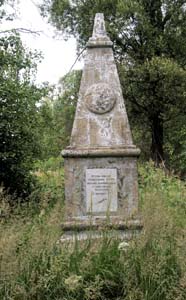
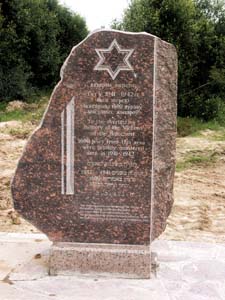 Memorial near Zaitsevo. Photo taken in 2008.
Memorial near Zaitsevo. Photo taken in 2008.
On that bloody morning, September 10th, 1941, Ignaty Ivanovich Lukianov was mowing grass near a village called Zaitsevo. He was about a hundred meters away from tank ditches. Not far from him Ulian Yegorovich Petrov was plowing land. They witnessed those shocking events. Ignaty Ivanovich Lukianov later described what had happened: “In the morning we saw about 15 Germans bring sixteen Jewish girls to the tank-ditch. When the car was passing us, I asked the girls: “Where are you going?” One of the girls answered: “To Demidov, to pick cucumbers”. She waved at me with her white handkerchief. The car stopped by the tank-ditch and the Germans each took a girl to the shrubs next to the ditch. Then we heard the girls shouting and groaning. It did not last long. Then they were dragged out, some on the hair, some on clothes – to the ditch. All of them were shot. Most probably they were raped before the execution. Then two more trucks with Jewish women arrived. They were also dragged out and shot in the ditch. Some of them were buried alive. After that there were two trucks with children, there were babies and children up to ten years old. They were all buried alive. The two trucks contained not less than a hundred children. After that more people were brought. Some were shot, some thrown into the ditch alive. Up to 1,600 people were slaughtered on that day. Seven big ditches were filled with corpses.” On November 2nd, 1943 the forensic expertise department of the Soviet Army organized exhumation of the graves. The size of three ditches, which were located between Yanovichi and Demidov, were 5x5 meters big and 4 meters deep. They were filled with corpses. After examining a body of a 2-year-old child they found no traces of wounds. The location of the mass grave was marked with a tab with only two words on it: “It is here”. The table was still there several years after the war. Memorials started to appear at the execution sites in the middle of the 50’s. Approximately in 1955 one memorial was set up at the site where the 1,600 people had been executed. One or two years later another memorial was set up in a place called Strelka, where 230 people had been shot. They were identical pyramids with five-edged stars at the top, the Belarusian coat of arms below and an inscription: “Eternal memory to the USSR citizens, mercilessly shot by Hitler bandits on Spetember 10th, 1941.” The word “Jews” was not mentioned anywhere… I visited that place 12 years ago. The memorial looked small and unattended, as if sinking in the ground. This time, when I came again, something surprised me – it looked different. I was also confused when I saw an inscription in Yiddish – did I fail to notice it the last time? Only at home, while comparing the photo, taken 12 years earlier with the new one, I realized the monument had been changed. The pyramid was now mounted onto a new tall pedestal. The tab with the inscription in Russian was attached to the bottom base. The inscription was still the same but there was another inscription in Yiddish as well. While visiting the memorials I was accompanied by Irina Izobova, a local school manager, and her husband Alezander Izobov, a local deputy. - Many people used to visit the memorial, - remembers Alexander. But nobody came during the last decade. - Ten years ago I received a letter from a former Yanovichi resident, - I said. – He asked what could be done to renovate the monument. Maybe this person did the renovations. Not long ago new memorials were erected at the sites. They were sponsored by the Lazarus family from the UK. These memorials have inscriptions in Belarusian and Hebrew. The memorial, erected in Strelka, fit in well. The other memorial near Zaitsevo, however, is about 300 meters away from the actual execution site. Most probably, they failed to reach the location by car and set it up by the road. This territory needs to be fenced. We would like to open a Memory Park in Strelka, - said Irina Izobova, - for the 500th anniversary of Yanovichi. Unfortunately, the local authorities do not have the finances, so we are looking for people who could be interested. |
|||
|
|
Jewish settlements in Vitebsk regionVitebsk • Albrehtovo • Babinovichi • Baran • Bayevo • Begoml • Beshenkovichi • Bocheikovo • Bogushevsk • Borkovichi • Braslav • Bychiha • Chashniki • Disna • Dobromysli • Dokshitsy • Druya • Dubrovno • Glubokoye • Gorodok • Kamen • Kohanovo • Kolyshki • Kopys • Krasnopolie • Kublichi • Lepel • Liady • Liozno • Lukoml • Luzhki • Lyntupy • Miory • Obol • Oboltsy • Orsha • Osintorf • Ostrovno • Parafianovo • Plissa • Polotsk • Prozorki • Senno • Sharkovshina • Shumilino • Sirotino • Slaveni• Smolyany • Surazh • Tolochin • Ulla • Verhnedvinsk • Vidzy • Volyntsy • Yanovichi • Yezerishe • Zhary • Ziabki • |
Main |
New publications |
Contacts |
Site map |
Vitebsk region |
Mogilev region |
Minsk region |